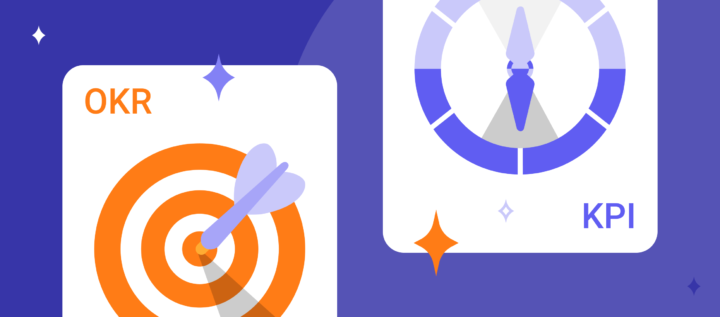How to develop a product strategy

This is an article for those who planned to develop a strategy but still haven’t done so, and now have to finally take up the challenge, and for those whose strategy wasn’t sufficiently connected to the tactical movement and daily tasks and didn’t work well under the current circumstances.
We’ll tell you how to:
- quickly develop a viable and adaptive strategy, rather than a document that will gather dust on someone’s Google Drive;
- make the company’s strategy work daily and every sprint, and in every environment;
- make sure that the strategy helps develop not only the company but the employees as well.
Iliah, the strategy, and product thinking mentor and the Head of Product of the Teachbase educational platform, helped us deal with these questions.
Spoiler alert: we have experienced this approach to strategy development on our own. And we liked it. And most importantly, this approach allows us to plan goals and objectives under the current uncertainty.
Why companies need strategy and tactics
Let’s start with our favorite question. Why?
The need to formalize a strategy normally doesn’t arise immediately but rather as the company — along with its product and team — are growing and expanding.
When you’re a small startup, everything is simple — you communicate daily, you are on the same page, decisions are being made together, and you have an opportunity to discuss the most important ones of them together. But then there are already 20, 30, 40 of you. And not everyone can answer the question of what you are doing and why, what is the company’s goal, who are the key customers, what market you are targeted at, what are the best customer engagement strategies to choose, and so on. Features start appearing chaotically, marketing and product teams are becoming less and less connected, and the sales team is trying to sell everything to everyone. You feel that the teams and the people inside them are out of focus, everyone has a different vision, everyone is running in different directions. You’re losing momentum, and the team loses their motivation.
Is that a familiar story? Well, we feel your pain!
We had such problems when there were over 30 of us. We grew up quickly, the company structure was being shaped, full-fledged teams appeared along with team leads. There were more and more people who could make decisions and they were making them daily. And it was no longer possible to discuss all the decisions. But all these decisions influenced the way the product and the company were developing.
The further away, the harder it was to manage the process and monitor the decisions made. I didn’t want to monitor the decisions, I just wanted there to be some rules by which they were made
Dimitri Ive, Dashly CEO & founder
Are you sure that’s not the case? Try a little research, talk to colleagues from different teams and ask them the following:
- how do they see the company’s future;
- what technologies and approaches they believe in,
- what they are willing to place a bet on.
You’ll see how different their visions are.
Read also:
⭐ Master Sales Funnel Email Sequence in 2025: Step-by-Step + 11 Real Examples
⭐ Leaky Sales Funnel? Here Are 6 Effective Strategies to Fix It
Ilya visualized it great for us:

To make sure this defocusing doesn’t cause damage to the company, especially amidst remote work and general overload, you need strategizing: you set goals and choose the direction in which everyone will move.

The strategy is an angle of 30 degrees
Iliah, strategy and product thinking mentor
Tactical planning allows you to outline a path, i.e. set smaller targets to make it easier to move.
Read also: What customer engagement platform is best for your business? 15 options to choose.

So, the №1 problem is defocusing.
What other problems are there?
Problem №2 is oblivion:
- The company already has a strategy, but nobody remembers it: the employees do not know about it, and the team leads recall it once a year.
Problem №3: the absence of decomposition:
- A strategy can be thought out at the level of top management, but then it is not decomposed into everyday practices.
Problem №3: unlucky release:
- The strategy is badly communicated to the team or simply badly written.
Problem №4: frustration:
- Besides, when strategic goals are not regularly achieved, the team’s trust in strategic management is lost.
Read also:
- Attract customers with these 24 ecommerce lead magnets
- The 7 Key Email Marketing Metrics & KPIs You Should Be Tracking
How to outline a strategy that will work in any environment
How to avoid these problems.
1.Convince everyone that without changes, the company can not continue to exist and develop.
Show everyone the results of your research proving the existence of real defocusing in the team. Explain how the situation will change with the emergence of a strategy.
2. Form a strategy with the team.
Do it during a strategic session. In the strategic session, people are engaged, everyone is involved in decision making. It’s clear to everyone what and where everything comes from. So the strategy will not be something that was brought from above or handed over from somewhere unknown.
Read also: Check the best customer engagement strategy Dashly clients use in 2023
3. Only write down the objective and strategic stakes.
Don’t write a manuscript. Choose an objective for the period you have set for yourself. Usually, the strategy is thought over for one, two or three years ahead.
4. Clearly articulate your stakes and divide them by directions.
We have the following:
- process and team stakes,
- product stakes,
- stakes related to marketing and sales.
5. Put the data at the heart of the strategy.
The strategy must be based on data so that it can be easily turned into action. Create a strategy based on market and competitor analysis, and your results in specific metrics. Without data, the strategy will be just beautiful words that mean nothing and are quickly forgotten.
6. Present your strategy well to the company.
A comprehensive presentation and a document that is easy to understand are mandatory. Amaze everyone.
7. Get ready to ask many questions.
You have to keep asking, “Do you remember where we’re going?” At every OKR sync-up session, when planning every sprint you have to ask yourself questions: “Does this match our strategic stakes? And will this lead us where we want to go? Will that happen after the time we’ve determined?”
Asking the same questions all the time is exhausting, but it helps run faster and in the right direction.
Check the best way to collect emails we tested this year.
How to correctly decompose the strategy: strategic, tactical and operational tasks
The company’s strategy exists at three levels: strategy, tactics, and operational processes.
What is there on different levels:
- strategic (the company level): objectives + strategic stakes;
- tactical, mid-term planning (company and team levels): quarterly OKRs, monthly sync-ups on them;
- operational (team and employee levels): daily processes — sprint setting (1-2 weeks) and their accomplishment.
A strategy only works as it should when all three levels are sequentially interconnected: the strategy is translated into tactics and the tactics into operations.
This bundle ensures that movement towards strategic objectives will not be interrupted. If there is no quarterly, monthly, or weekly planning, the connection is lost, and the strategy doesn’t work.
Read also:
👉 How to use lead generation chatbot for your website
👉Lead nurturing platform for your revenue growth
👉 12 types of marketing nurture campaigns
Strategic level: objective and stakes
This is the upper level of planning. Here are the company’s objectives for the period and strategic stakes.
The objective is what you are heading to.
The objective can be expressed in the metric values (MRR or ARR), describe the desired position in the market (“to become a market leader”, “enter the top 3”) or the stage of company growth (“attract X in investments”), etc. There may be several or one objective. We decided to have one objective.
Strategic stakes are the principles and restrictions you set so as not to “walk away” from the path to your objective. In this case, strategic stakes are similar to gambling bets. These are solutions, approaches, products, and technologies that you believe in, on which you are ready to “bet” resources — above all, the time of your team.
How stakes work
It is important that a good strategy simultaneously shows where to go and what not to do. There are clear directions which are the stakes. If the objective is the movement direction, then stakes are guiding controllers. You have to learn not to do anything that contradicts them.
Here are some examples of our strategic stakes:
- Easily embed into the customer ecosystem through integrations.
- Be a company with modern design (UX, UI).
- “First-give” approach.
“Strategic stakes are a good way to limit your choices so that all decisions are made in the right direction”.
Dimitri Ive, Dashly CEO & founder
There is an integration stake, and we study the digital ecosystems of our customers to better and faster integration into their business processes, rather than developing new functions whose work is already done by other services.
Or the “first-give” approach. We believe that if you are helpful to users, to the community, people will reach out to you. This is the principle we’ve been following since the introduction of Dashly.
Tactical level: OKR
Trying to put the strategy into operations immediately leads to the fact that you don’t know what to do every day to achieve your objectives. Therefore, a tactical level appears. At this level, OKRs are formed.
OKR (Objectives and key results) are objectives and key results for a certain period.
What the OKRs are made of:
The objective for the OKR period. It should be ambitious, challenging, focusing. Each such objective should have between 2 and 5 key results.
Key results are methods or ways of verifying that an objective has been achieved. They should be unambiguous, verifiable, and transparent.
Initiatives are significant changes, internal projects or big hypotheses that should lead us to a big objective.
OKRs can be quarterly or monthly. Sometimes OKRs are referred to as a strategic planning tool, but they are not. OKRs are a tactical planning tool. OKRs are usually expressed in metrics. And this is how they differ from stakes: OKRs are numbered, but stakes are something that cannot be digitized.
The decomposition is as follows: the strategy is formulated for the year, tactical objectives are set for a quarter. Tactical objectives should help achieve strategic ones. Next, the quarterly OKRs and the monthly OKRs are set.

Achieving strategic objectives is like trekking in the mountains: to reach the highest peak, you have to reach a few smaller ones. Smaller peaks are OKRs
Iliah, strategy and product thinking mentor
Operational level: sprint tasks and daily processes
Sprints and weekly planning are organized so that the team can achieve monthly OKRs.
How decomposition works at this level:
- you formulate quarterly OKRs;
- give time to your team;
- each participant takes their initiative;
- the whole team decides how to allocate the tasks;
- you align on deadlines for specific tasks.
When there are OKRs, you know from the level of the entire company and ideally to each person, what and in what time frame you need to do to improve some or other performance indicators.
A big objective may seem scary, unattainable. The simple arithmetic and decomposition by months and sprints remove the paralysis of incomprehension. You do a piece of work and you know why it’s important. And it makes it easier to work
David, Head of Marketing at Dashly
And strategic stakes give the team the necessary focus not to do everything at once.
The objective of stakes is to bring everyone to a common standard. So that everyone is on the same page in the team, knows their limitations and focuses on what they need to do for the company to achieve its objective
Tim, Head of Product at Dashly
Are personal OKRs necessary?
Personal OKRs should only be introduced if desired. Our experience has shown that personal OKRs are a great thing and that they inevitably emerge in a healthy team. If you have an initiating team and the guys are not afraid to take responsibility, you will also have personal OKRs.
Several guys on my team have got personal OKRs after a strategic session, and I’m helping them achieve them. We’ve made personal development plans before, but now we’re talking about development and helping the company at the same time. It’s great
Dimitri Ive, Head of Product at Dashly
How not to forget about the strategy
- Pin stakes and OKRs
We need to make sure that the list of them is always accessible. It’s best if they’re always in front of your eyes. Pin them up wherever you can. In Miro, Notion or Favro. In Favro, link them to OKRs and link OKRs to specific tasks.

- Discuss them
Open and honest communication is useful. The more often someone from the team remembers the stakes, the quicker everyone else remembers them. At first, it will be those who took part in the development of them. But over time, if all tasks are discussed from this point of view, they will be remembered by everyone.
Doubtful stakes need to be discussed, too. One of the advantages of this strategy format is that the company remains flexible, rather than following one strategy for 10 years. If you see that one of the stakes is not working, you can review it after discussion and based on the data. This can be done after a quarter or half a year.
We have special rituals to synchronize regularly at the team lead level: we call them “lead fights” and hold them twice a month. We also discuss how these or that stakes work. This allows us to remember them and remain flexible.
- Review any task for compliance with strategic stakes
You have to keep asking yourself and the rest of the team a lot of questions:
- where we are;
- what we do and why;
- where we are heading;
- where we should be heading;
- what we need to do and what we don’t;
- whether this or that task matches our strategic stakes.
And no matter if you have invented this task yourself or got it from someone.
- Regularly hold OKR sync-ups
We hold these sync-ups once a month and sometimes after every sprint.
- Secure agreements between people and connections between tasks
And most importantly, there is a bureaucracy on the tactical and operational levels. There should be no tasks or projects stuck in the air; each task should have an owner and it should be clear how it affects the movement towards a common objective. This has to be documented. We do this in Favro. Moreover, the Product board is connected to the OKR board and you can see that this or that task is the OKR one. In addition, we write the job that it performs according to JTBD for each task.

The feature card in Favro
How to exercise strategic thinking
- Document objectives and results
Each hypothesis and task should have an expected outcome. The more often you compare the expected outcome with the real one, the better you will be able to predict the achievement of the objectives. At the same time, you should always come up with ideas, generate hypotheses and provide time resources and budget for their verification.
- Analyze the results and prerequisites and develop system thinking
By developing system thinking and personal awareness, you develop strategic thinking. Learn to find patterns and connections between the events that happen around you, constantly practice looking for cause-and-effect relationships, and draw conclusions based on the relationships of events.
- Start from tactics
A good approach is to start a tactical movement first, and then move on to a strategic one. This way, you will learn how to plan objectives and achieve them together and avoid frustrations caused by the unattainability of a strategic goal and the team’s unpreparedness for the chosen pace.
That’s what we had: we first introduced OKRs and learned to live with them. It wasn’t easy.
“With every step of OKR, we understood: we have to do better, we have to correct our mistakes”.
Tim, Head of Product at Dashly
This is how we came to realize the need to formalize the strategy. Now it’s easier for us to implement it as we already have the team skills of tactical movement.
You have to gradually level up the skill to move forward, to move tactically like a muscle
Iliah, strategy and product thinking mentor
We have formed our strategy during the strategic session. And we advise everyone to do the same! In the next article, we will certainly tell you how it was, what it cost us, and how strategic stakes help us move every day towards a big objective and not panic in uncertain circumstances.
Read also:
- Client onboarding: how to engage, retain, and win users in 2022
- 5 ways of user tracking on website for newbies and tech-savvy
- Choose the best Chatbot Platform to Start Conversation with Users







